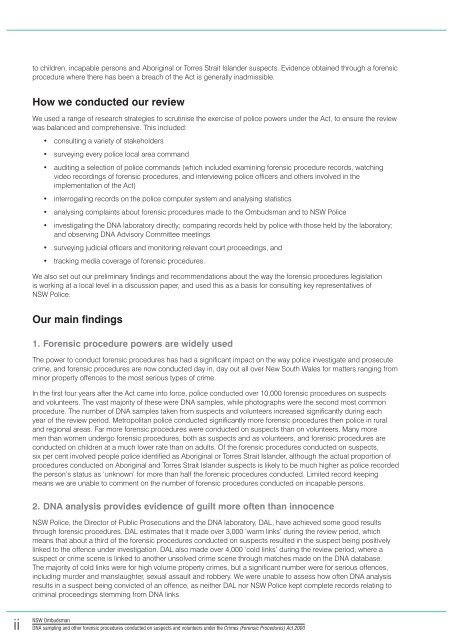Crimes (Forensic Procedures) Act 2000 - NSW Ombudsman - NSW ...
Crimes (Forensic Procedures) Act 2000 - NSW Ombudsman - NSW ...
Crimes (Forensic Procedures) Act 2000 - NSW Ombudsman - NSW ...
You also want an ePaper? Increase the reach of your titles
YUMPU automatically turns print PDFs into web optimized ePapers that Google loves.
to children, incapable persons and Aboriginal or Torres Strait Islander suspects. Evidence obtained through a forensic<br />
procedure where there has been a breach of the <strong>Act</strong> is generally inadmissible.<br />
How we conducted our review<br />
We used a range of research strategies to scrutinise the exercise of police powers under the <strong>Act</strong>, to ensure the review<br />
was balanced and comprehensive. This included:<br />
• consulting a variety of stakeholders<br />
• surveying every police local area command<br />
• auditing a selection of police commands (which included examining forensic procedure records, watching<br />
video recordings of forensic procedures, and interviewing police officers and others involved in the<br />
implementation of the <strong>Act</strong>)<br />
• interrogating records on the police computer system and analysing statistics<br />
• analysing complaints about forensic procedures made to the <strong>Ombudsman</strong> and to <strong>NSW</strong> Police<br />
• investigating the DNA laboratory directly; comparing records held by police with those held by the laboratory;<br />
and observing DNA Advisory Committee meetings<br />
• surveying judicial officers and monitoring relevant court proceedings, and<br />
• tracking media coverage of forensic procedures.<br />
We also set out our preliminary findings and recommendations about the way the forensic procedures legislation<br />
is working at a local level in a discussion paper, and used this as a basis for consulting key representatives of<br />
<strong>NSW</strong> Police.<br />
Our main findings<br />
1. <strong>Forensic</strong> procedure powers are widely used<br />
The power to conduct forensic procedures has had a significant impact on the way police investigate and prosecute<br />
crime, and forensic procedures are now conducted day in, day out all over New South Wales for matters ranging from<br />
minor property offences to the most serious types of crime.<br />
In the first four years after the <strong>Act</strong> came into force, police conducted over 10,000 forensic procedures on suspects<br />
and volunteers. The vast majority of these were DNA samples, while photographs were the second most common<br />
procedure. The number of DNA samples taken from suspects and volunteers increased significantly during each<br />
year of the review period. Metropolitan police conducted significantly more forensic procedures then police in rural<br />
and regional areas. Far more forensic procedures were conducted on suspects than on volunteers. Many more<br />
men than women undergo forensic procedures, both as suspects and as volunteers, and forensic procedures are<br />
conducted on children at a much lower rate than on adults. Of the forensic procedures conducted on suspects,<br />
six per cent involved people police identified as Aboriginal or Torres Strait Islander, although the actual proportion of<br />
procedures conducted on Aboriginal and Torres Strait Islander suspects is likely to be much higher as police recorded<br />
the person’s status as ‘unknown’ for more than half the forensic procedures conducted. Limited record keeping<br />
means we are unable to comment on the number of forensic procedures conducted on incapable persons.<br />
2. DNA analysis provides evidence of guilt more often than innocence<br />
<strong>NSW</strong> Police, the Director of Public Prosecutions and the DNA laboratory, DAL, have achieved some good results<br />
through forensic procedures. DAL estimates that it made over 3,000 ‘warm links’ during the review period, which<br />
means that about a third of the forensic procedures conducted on suspects resulted in the suspect being positively<br />
linked to the offence under investigation. DAL also made over 4,000 ‘cold links’ during the review period, where a<br />
suspect or crime scene is linked to another unsolved crime scene through matches made on the DNA database.<br />
The majority of cold links were for high volume property crimes, but a significant number were for serious offences,<br />
including murder and manslaughter, sexual assault and robbery. We were unable to assess how often DNA analysis<br />
results in a suspect being convicted of an offence, as neither DAL nor <strong>NSW</strong> Police kept complete records relating to<br />
criminal proceedings stemming from DNA links.<br />
ii<br />
<strong>NSW</strong> <strong>Ombudsman</strong><br />
DNA sampling and other forensic procedures conducted on suspects and volunteers under the <strong>Crimes</strong> (<strong>Forensic</strong> <strong>Procedures</strong>) <strong>Act</strong> <strong>2000</strong>

















